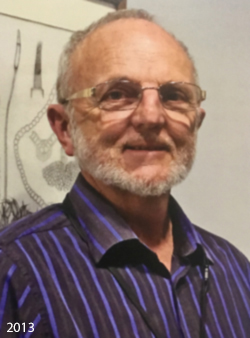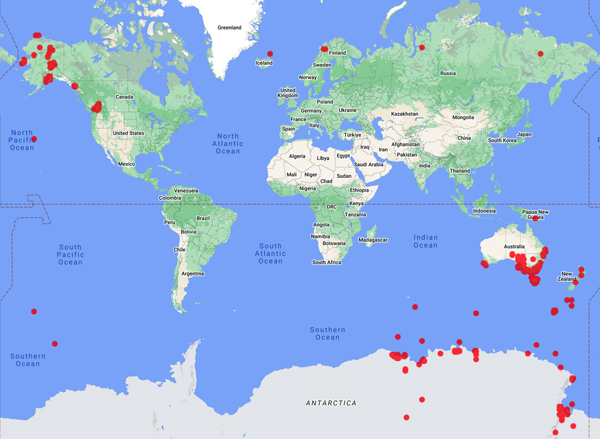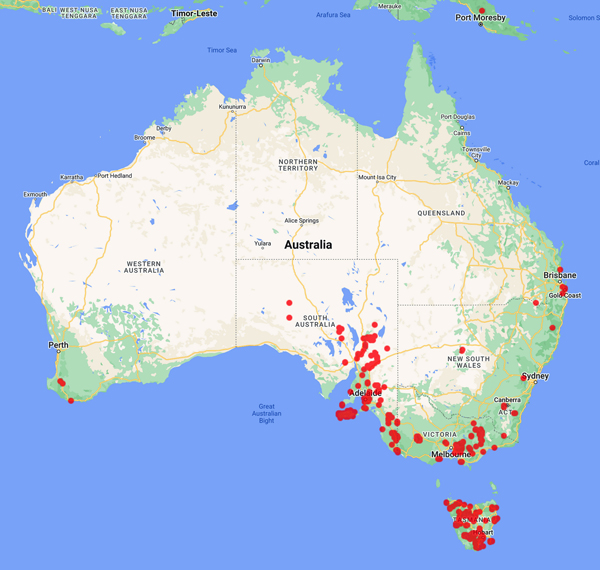
Council of Heads of Australasian Herbaria
Australian National Herbarium
Biographical Notes
 |
Council of Heads of Australasian Herbaria |
 Seppelt, Rodney David (Rod) (1945 - )
Seppelt, Rodney David (Rod) (1945 - )Born in Tanunda, South Australia, 10 December 1945;
Rod was educated at St. Peter's College, Adelaide, and then The University of Adelaide
(BSc Hons - 1972, MSc - revision of the hepatic genus Riccia in South Australia -
awarded 1974) and The University of Melbourne (PhD study on a revision of the
moss flora of subantarctic Macquarie Island and the genera Ditrichum,
Distichium and Pseudodistichium in Australasia - awarded 1978).
Intended as the basis of a revision of the genus Viola in Australia, extensive
collections in South Australia, Victoria and Tasmania resulted in a revision of
the genus for the Flora of South Australia before abandoning the project as a PhD
study. The collections are housed primarily in MELU and HO.
Interest in lichens arose from assisting a doctoral student at The University of
Adelaide (Rod Rogers) with field work in arid regions of South Australia. Interest
in bryophytes arose from undergraduate courses in comparative morphology of
non-flowering plants at The University of Adelaide.
A deep interest in comparative
morphology arose from the emphasis placed on anatomy in undergraduate
courses.
An interest in botanical art stemmed from a natural artistic bent and art instruction
at school, as well as the requirement for accurate illustrative representation in
undergraduate courses in Botany and Zoology and the presence in the Botany
Department at The University of Adelaide of a full-time artist (Veda Cruickshank) attached to the
Marine Algal research group.
After transferring from Adelaide to Melbourne, an
association with George Scott and Celia Rosser, at Monash University, and Ilma
Stone, at The University of Melbourne, further fostered a drift towards botanical
art as being an integral part of systematics research as well as being aesthetically
rewarding.
A teacher at the school in Adelaide spent a year as a weather observer at
Mawson Station in Antarctica and on returning presented an illustrated talk
on his year away, sparking Rod's long-standing interest in the Antarctic and
Arctic regions. Involvement in Antarctic and subantarctic botanical research
commenced in 1971 with a summer visit to Mawson Station and Macquarie Island.
A further visit to Macquarie Island in 1975, Davis Station and the Vestfold Hills
in 1978, Casey Station also in 1978, heralded a long association with Antarctic
and subantaretic research activities that included a Visiting Professorship term
at the National Institute of Polar Research, Tokyo, in 1985, and nine summer
seasons with Antarctica New Zealand and the University of Waikato Antarctic
Research Program.
Altogether, some 42 visits were made to the subantarctic and
Antarctic region and nine summer field seasons in the Arctic (Alaska, Sweden
and Norway).
The Antarctic plant collections formerly housed in the Australian Antarctic Division Herbarium (ADT), (now
transferred to HO), represent the greatest geographic spread of any Antarctic
botanical collection, following personal visits to almost half of the Antarctic
continent.
Prior to taking up the appointment of ABLO at Kew, Rod and his wife spent three
months in the United States of America at the University of Alaska Fairbanks.
The Seppelts arrived at Kew on 18 September 2000, missing an overlap with the previous ABLO, Bob Chinnock. Rod finished his ABLO term on 31 August, 2001.
On returning to Australia he resumed employment at the Australian Antarctic Division and continued there until retirement in December 2012.
Most of the information on original publications of moss names (full publication
reference details, publication dates, page numbers) were saved to disc.
Photocopies of many of the publications were obtained and stored as hard
copy. This information has been transferred to the Tasmanian Herbarium (HO),
along with the extensive personal herbarium (formerly registered as ADT)
accumulated by Rod Seppelt since 1971.
Apart from curatorial responsibility for the
collection (lichens, bryophytes, algae, vascular plants), Rod has continued
his botanical art projects, illustrating the family Pottiaceae for the Moss Flora
of New Zealand, various illustrated projects on the mosses of Tasmania, a fully
illustrated revision of the genus Fissidens and a large number of drawings for the
Moss Flora of Australia.
He is currently [2023] an Honorary Botanist at the Tasmanian
Herbarium and for three years edited the Journal Kanunnah of the Tasmanian
Museum and Art Gallery, until it ceased publication with Volume 7.
Since relocating to Queensland in 2016, Rod has continued illustrating mosses and
revisionary studies (families Bruchiaceae, Calymperaceae, Fisidentaceae). By
2013 some 80% of the Tasmanian mosses (4 of 6 fascicles published) and 80% of
the Queensland mosses had been illustrated.
Source: Extracted from:
George, Alex (Ed), The Australian Botanical Liaison Officer scheme at Kew, 1937-2009, Four Gables Press, Perth, 2023.
Portrait Photo: 2013, Jacquie Ward, Tas Museum & Art Gallery (from above book).
Data from 6,428 specimens

